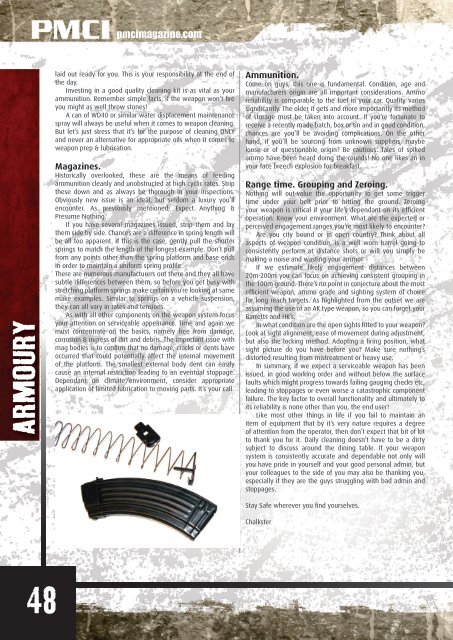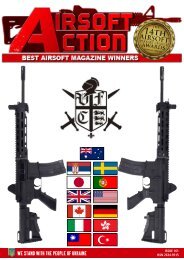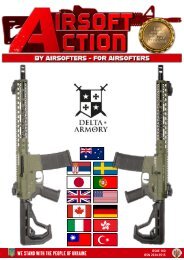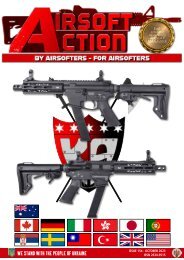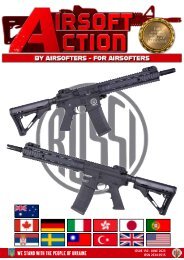PMCI - May 2016
Welcome to the May 2016 Issue of PMCI - the only magazine dedicated to the PMC sector. In this issue we take a look at "SimGun", which brings training close to reality but without the risks. We also speak to EUSECA UK about how to deal with the dreaded "active shooter" scenario. Kit-wise, we get together with Helikon-Tex to check out their latest products and meet British brand "Bulldog" to take a look at their "bomber tough" tactical gear. We also get our hands on some stunning new helmet models from Armorsource and PMCI Editor, Bill, brings us his take on the tactical area at the 2016 IWA show in Nuremberg. Not forgetting firearms, we see what happens when you take a well-known handgun and add some custom parts, while our two "tame" contractors discuss how they prepare their primary when they get in-country. We also welcome new contributor "Chalky" White to PMCI, as he gives us some tips on how to get the very best from your contract-issued AK.
Welcome to the May 2016 Issue of PMCI - the only magazine dedicated to the PMC sector.
In this issue we take a look at "SimGun", which brings training close to reality but without the risks. We also speak to EUSECA UK about how to deal with the dreaded "active shooter" scenario.
Kit-wise, we get together with Helikon-Tex to check out their latest products and meet British brand "Bulldog" to take a look at their "bomber tough" tactical gear. We also get our hands on some stunning new helmet models from Armorsource and PMCI Editor, Bill, brings us his take on the tactical area at the 2016 IWA show in Nuremberg.
Not forgetting firearms, we see what happens when you take a well-known handgun and add some custom parts, while our two "tame" contractors discuss how they prepare their primary when they get in-country. We also welcome new contributor "Chalky" White to PMCI, as he gives us some tips on how to get the very best from your contract-issued AK.
Create successful ePaper yourself
Turn your PDF publications into a flip-book with our unique Google optimized e-Paper software.
pmcimagazine.com<br />
ARMOURY<br />
laid out ready for you. This is your responsibility at the end of<br />
the day.<br />
Investing in a good quality cleaning kit is as vital as your<br />
ammunition. Remember simple facts, if the weapon won’t fire<br />
you might as well throw stones!<br />
A can of WD40 or similar water displacement maintenance<br />
spray will always be useful when it comes to weapon cleaning.<br />
But let’s just stress that it’s for the purpose of cleaning ONLY<br />
and never an alternative for appropriate oils when it comes to<br />
weapon prep & lubrication.<br />
Magazines.<br />
Historically overlooked, these are the means of feeding<br />
ammunition cleanly and unobstructed at high cyclic rates. Strip<br />
these down and as always be thorough in your inspections.<br />
Obviously new issue is an ideal, but seldom a luxury you’ll<br />
encounter. As previously mentioned; Expect Anything &<br />
Presume Nothing.<br />
If you have several magazines issued, strip them and lay<br />
them side by side. Chances are a difference in spring length will<br />
be all too apparent. If this is the case, gently pull the shorter<br />
springs to match the length of the longest example. Don’t pull<br />
from any points other than the spring platform and base ends<br />
in order to maintain a uniform spring profile.<br />
There are numerous manufacturers out there and they all have<br />
subtle differences between them, so before you get busy with<br />
stretching platform springs make certain you’re looking at same<br />
make examples. Similar to springs on a vehicle suspension,<br />
they can all vary in rates and tensions.<br />
As with all other components on the weapon system focus<br />
your attention on serviceable appearance. Time and again we<br />
must concentrate on the basics, namely free from damage,<br />
corrosion & ingress of dirt and debris. The important issue with<br />
mag bodies is to confirm that no damage, cracks or dents have<br />
occurred that could potentially affect the internal movement<br />
of the platform. The smallest external body dent can easily<br />
cause an internal restriction leading to an eventual stoppage.<br />
Dependant on climate/environment, consider appropriate<br />
application of limited lubrication to moving parts. It’s your call.<br />
Ammunition.<br />
Come on guys, this one is fundamental. Condition, age and<br />
manufacturers origin are all important considerations. Ammo<br />
reliability is comparable to the fuel in your car. Quality varies<br />
significantly. The older it gets and more importantly its method<br />
of storage must be taken into account. If you’re fortunate to<br />
receive a recently made batch, box or tin and in good condition,<br />
chances are you’ll be avoiding complications. On the other<br />
hand, if you’ll be sourcing from unknown suppliers, maybe<br />
loose or of questionable origin? Be cautious. Tales of spiked<br />
ammo have been heard doing the rounds! No one likes an in<br />
your face breech explosion for breakfast.<br />
Range time. Grouping and Zeroing.<br />
Nothing will out-value the opportunity to get some trigger<br />
time under your belt prior to hitting the ground. Zeroing<br />
your weapon is critical if your life’s dependant on its efficient<br />
operation. Know your environment. What are the expected or<br />
perceived engagement ranges you’re most likely to encounter?<br />
Are you city bound or in open country? Think about all<br />
aspects of weapon condition, is a well worn barrel going to<br />
consistently perform at distance shots or will you simply be<br />
making a noise and wasting your ammo!<br />
If we estimate likely engagement distances between<br />
20m-200m you can focus on achieving consistent grouping in<br />
the 100m ground. There’s no point in conjecture about the most<br />
efficient weapon, ammo grade and sighting system of choice<br />
for long reach targets. As highlighted from the outset we are<br />
assuming the use of an AK type weapon, so you can forget your<br />
Barretts and HK’s.<br />
In what condition are the open sights fitted to your weapon?<br />
Look at sight alignment, ease of movement during adjustment,<br />
but also the locking method. Adopting a firing position, what<br />
sight picture do you have before you? Make sure nothing’s<br />
distorted resulting from mistreatment or heavy use.<br />
In summary, if we expect a serviceable weapon has been<br />
issued, in good working order and without below the surface<br />
faults which might progress towards failing gauging checks etc,<br />
leading to stoppages or even worse a catastrophic component<br />
failure. The key factor to overall functionality and ultimately to<br />
its reliability is none other than you, the end user!<br />
Like most other things in life if you fail to maintain an<br />
item of equipment that by it’s very nature requires a degree<br />
of attention from the operator, then don’t expect that bit of kit<br />
to thank you for it. Daily cleaning doesn’t have to be a dirty<br />
subject to discuss around the dining table. If your weapon<br />
system is consistently accurate and dependable not only will<br />
you have pride in yourself and your good personal admin, but<br />
your colleagues to the side of you may also be thanking you,<br />
especially if they are the guys struggling with bad admin and<br />
stoppages.<br />
Stay Safe wherever you find yourselves.<br />
Chalkster<br />
48


